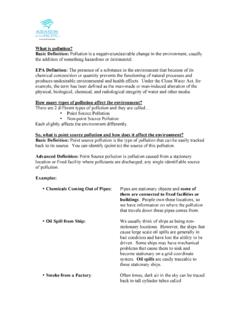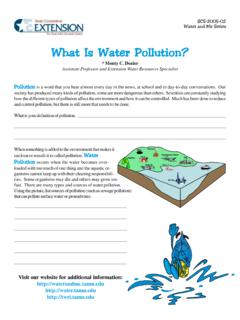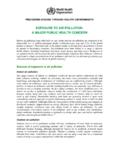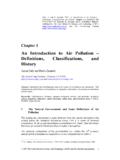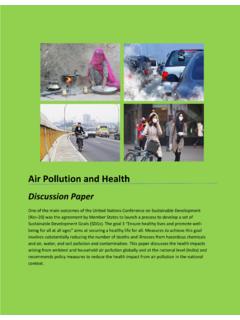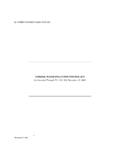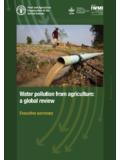Transcription of The economic consequences of outdoor air …
1 The economic consequences of outdoor air pollution POLICY HIGHLIGHTSCIRCLEAir pollution is one of the most serious environmental risks. The most recent Global Burden of Disease (GBD) study estimates that air pollution indoor and outdoor combined was the cause of million premature deaths globally in 2013. Air pollution also has further consequences on human health, leading in particular to an increasing number of respiratory and cardiovascular diseases. Moreover, it affects crop yields and the environment, with impacts on biodiversity and ecosystems, amongst others. These impacts have significant economic consequences , which will affect economic growth as well as welfare. This report,The economic consequences of outdoor Air pollution , presents projections of the costs of outdoor air pollution , focusing on impacts on human health, including both mortality and morbidity, and agriculture.
2 Both the consequences for the economy and the welfare costs from premature deaths and pain and suffering are quantitatively assessed. Other impacts, such as those on biodiversity and other health impacts ( the direct effects of NO2 exposure) could not be calculated as there is not yet enough information available. While indoor air pollution is also the cause of a large number of premature deaths, this report focuses on outdoor air pollution only. This report is part of the CIRCLE project on Costs of Inaction and Resource scarcity: consequences for Long-term economic growth , which seeks to take into account the feedbacks from environmental pressures and resource scarcity to the POLICY HIGHLIGHTS The economic consequences of outdoor air pollution - 1 The economic consequences of outdoor AiR PoLLuTionfindings Air pollution already affects human health, agriculture and leads to a range of other impacts.
3 These impacts are projected to become much more severe in the coming decades. In absence of additional and more stringent policies, increasing economic activity and energy demand will lead to a significant increase in global emissions of air pollutants, according to projections using the OECD s ENV-Linkages model. Rising emissions of air pollutants are projected to lead to higher concentrations of particulate matter ( ) and ground level ozone. In several regions of the world, average concentrations of and ozone are already well above the levels recommended by the WHO Air quality guidelines. The projected increase in concentrations of and ozone will in turn lead to substantial effects on the economy. According to the calculations in this report, global air pollution -related healthcare costs are projected to increase from USD 21 billion (using constant 2010 USD and PPP exchange rates) in 2015 to USD 176 billion 2005 in 2060.
4 By 2060, the annual number of lost working days, which affect labour productivity, are projected to reach billion (currently around billion) at the global level. The market impacts of outdoor air pollution , which include impacts on labour productivity, health expenditures and agricultural crop yields, are projected to lead to global economic costs that gradually increase to 1% of global GDP by 2060. The most dangerous consequences from outdoor air pollution are related to the number of premature deaths. This report projects an increase in the number of premature deaths due to outdoor air pollution from approximately 3 million people in 2010, in line with the latest Global Burden of Disease estimates, to 6-9 million annually in 2060. A large number of deaths occur in densely populated regions with high concentrations of and ozone, especially China and India, and in regions with aging populations, such as China and Eastern Europe.
5 The annual global welfare costs associated with the premature deaths from outdoor air pollution , calculated using estimates of the individual willingness-to-pay to reduce the risk of premature death, are projected to rise from USD 3 trillion in 2015 to USD 18-25 trillion in 2060. In addition, the annual global welfare costs associated with pain and suffering from illness are projected to be around USD trillion by 2060, up from around USD 300 billion in 2015, based on results from studies valuating the willingness-to-pay to reduce health risks. Policies to limit air pollution emissions would lead to an improvement in air quality, reduce risks of very severe health impacts, and, if properly implemented, generate considerable climate co-benefits. The potential economic consequences of both the market and non-market impacts of outdoor air pollution are very significant and underscore the need for strong policy action.
6 There s no one-size-fits-all recipe for reducing the impacts of air pollution . As both the sources of air pollutant emissions and the economic consequences of air pollution are very unequally distributed across different regions, policies need to be tailored to specific local circumstances. Nevertheless, the implementation of policies, such as incentivising the adoption of end-of-pipe technologies, implementing air quality standards and emission pricing, will certainly help avoid the worst impacts of outdoor air pollution . POLICY HIGHLIGHTS1 Modelling the economic consequences of outdoor air pollution requires several steps that link economic activity to emissions, concentrations, exposure, biophysical impacts and finally valuation of the economic costs (Figure 1).1. The OECD s ENV-Linkages model, a computable general equilibrium (CGE) model, is used to create detailed projections of sectoral and regional economic activities from 2015 to 2060.
7 2. For each year, emissions of a range of air pollutants are linked in ENV-Linkages to the different economic activities, using emission coefficients derived from the GAINS model developed at the International Institute for Applied Systems Analysis (IIASA). In some cases, emissions are directly linked to the relevant element in the production process, such as the combustion of fossil fuels. In other cases, emissions are linked to the scale of activity, and thus to production Emissions of air pollutants are used to calculate concentrations of particulate modelling the economic consequences of outdoor air pollution2 - OECD POLICY HIGHLIGHTS The economic consequences of Climate Change matter ( ) and ozone with the TM5-FASST atmospheric dispersion model of the European Commission s Joint Research Centre (EC-JRC).
8 4. The biophysical impacts caused by the population-weighted concentrations of and ozone, including impacts on number of lost working days, hospital admissions and agricultural productivity, are calculated using demographic projections, exposure to the pollutants and results of studies calibrating concentration-response functions. 5. The economic consequences of outdoor air pollution are calculated by attributing a monetary value to each health endpoint. For example, hospital admissions are translated into health expenditures. The macroeconomic costs of those impacts of outdoor air pollution that are linked to economic activity are then calculated using the ENV-Linkages general equilibrium model. Welfare costs related to mortality and pain and suffering from illness are calculated using results from direct valuation 1.
9 Steps to study the economic consequences of outdoor air pollutionEconomic activityEmissionsConcentrationsBiophyisi cal impactsEconomic costsThe total cost of inaction on outdoor air pollution include both market and non-market costs (Figure 2). Market costs are those that are associated with biophysical impacts that directly affect economic activity as measured in the national accounts and GDP. For example, lower crop yields affect agricultural production. Non-market costs include the monetised welfare costs of mortality (premature deaths), and of the disutility of illness (pain and suffering). 2 - OECD POLICY HIGHLIGHTS The economic consequences of outdoor air pollution OECD POLICY HIGHLIGHTS The economic consequences of outdoor air pollution - 3 POLICY HIGHLIGHTSF igure 2. cost categories considered The market impacts, which in this study comprise additional health expenditures due to illness, labour productivity losses due to absences from work for illness, and agricultural yield losses, are included in the ENV-Linkages model to calculate the global and regional costs of outdoor air pollution on sectoral production, GDP and welfare.
10 Thanks to the general equilibrium framework of the ENV-Linkages model, the market costs include both direct and indirect market costs. For instance, a decrease in crop yields will lead to a direct impact on agricultural output of the affected crops, but also to indirect effects, including substitution by other crops and changes in trade patterns. Non-market impacts cannot be easily accounted for in a general equilibrium framework as they are not linked to any specific variable in the production or utility functions of the model. The welfare costs of non-market impacts are evaluated using estimates of willingness-to-pay to reduce health risks obtained from results of existing direct valuation studies. 2 - OECD POLICY HIGHLIGHTS The economic consequences of outdoor air pollution DisutilityofillnessMortalityMarket costsDirect costsLabourproductivityHealth expendituresAgriculturalyieldsNon-market costsIndirect costsDisutilityofillnessMortalityMarket costsDirect costsLabourproductivityHealth expendituresAgriculturalyieldsNon-market costsIndirect costs4 - OECD POLICY HIGHLIGHTS The economic consequences of outdoor air pollution OECD POLICY HIGHLIGHTS The economic consequences of outdoor air pollution - 5 Source: ENV-Linkages model, based on projections of emission factors from the GAINS and concentrations of outdoor air pollutantsFor most air pollutants, emissions are projected to increase in the coming decades (Figure 3).










